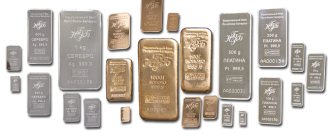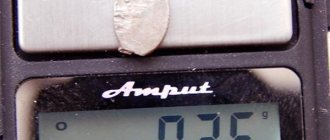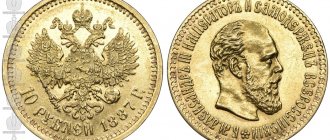Gold bar
Once upon a time there lived the Inca people. It was a developed tribe for its time. They had a lot of gold, so much that they made household items, toys and jewelry from it. And it was like that before the arrival of Europeans. The Spanish conquistadors took the available gold and poured ordinary bricks out of beautiful figurines and objects. This is where the rush for gold began, not as a natural miracle, but as an instrument of power.
And now many are interested in how much a gold bar weighs. After all, when these “bricks” are shown in photographs or films, they seem weighty and large. In fact, there are several banking standards that determine the weight of a gold bar. Let us immediately note that purchasing a gold bar is more of a long-term investment. Since in the future it still has to be sold or given away for further processing.
Types of ingots
Gold bars are used as an investment object, raw material for making jewelry, and gifts. Depending on the method of application, the metal is given different weight, shape and appearance. Refineries are engaged in the production of such products.
Measured
Bullion bars are intended for individuals and can be bought and sold at a bank or jewelry store. For ease of circulation, they are issued in different weights, similar to the denominations of banknotes.
Standard
The standard version is not intended for everyday use. Its purpose is as raw material for jewelry workshops and factories, so the form of their production is not very diverse.
Technological differences
The methods for making such things also differ. Small products - up to 50 grams - are produced using stamping. The surface of the metal turns out to be very beautiful - smooth and neat, with perfectly executed details of inscriptions and drawings.
Larger specimens are produced by casting. The appearance of cast products is not so perfect, but this manufacturing method is cheaper.
There is also a powder production method - by electrolysis, but it is not used in Russia.
Modern gold bars
Despite the fact that many millennia have passed, in the modern world gold is still the main indicator of the well-being of any country. All gold bars have a monetary equivalent, which most often grows over time. The owner of this metal will always be able to profitably (at the exchange rate) exchange it for any financial value. Gold is always a profitable investment.
The term “ingot” implies that the precious metal is of high purity. Gold bars form the country's gold reserve; they serve as an anti-crisis reserve and adjust the exchange rate of the national currency. Sufficient reserves of gold in the vaults of state banks guarantee greater economic independence of the country.
Types of gold bars
Gold bars are divided into two categories based on weight, quality and manufacturing process requirements. The classification looks like this:
- Measured gold bars correspond to a specific set of technological processes for purification from impurities (refining) at a given manufacturing plant. The weight of a measured ingot can be from 1 to 1000 grams, and the share of gold itself in the total mass must correspond to 99.99%. Such alloys with low weight are available for purchase in Russian banks.
- Standard ingots comply with the requirements of state standards of the Russian Federation.
Additional requirements are imposed on measuring products in accordance with GOST R 51572-2000. Namely:
- absence of damage and fatty film on the product;
- slight concavities or convexities are possible;
- compliance with appropriate dimensions according to weight;
- Each copy is accompanied by a certificate listing its characteristics;
- mandatory marking with the name of the country (in an oval), name of the alloy, weight, % mass fraction, product number and manufacturer's mark.
According to the manufacturing method, ingots are: cast - they are obtained by pouring molten metal into ready-made molds, their weight often starts from 500 g and stamped - smooth, attractive, they are made by pressing a stamp onto the molten metal. The stamped method is much more expensive, but the ingots are liquid, thanks (among other things) to their low weight of up to 500 g.
Weight
The weight of gold bars is usually measured in grams, but in the world market the troy ounce is often used. When selling and purchasing gold alloys, this unit of measurement is often used by banks in our country. An ounce is 31.1035 grams. The weight of a standard gold bar varies. Dimensional ingots are produced in two types:
- cast - SLZ (made of gold);
- stamped - SSHZ (made of gold).
Next, after the letter marking, a digital number is placed, which corresponds to the weight of the product. For example, SSHZ 50 means that an ingot stamped from gold weighing 50 grams. There is a table of the weight of gold in different bars according to GOST of the Russian Federation:
Gold bar price
Gold metal can vary in value depending on the time, political and economic situation in the country and the world. For example, in July 2021, bars could be purchased from banks for several hundred rubles cheaper than in December. Geographical location can also affect the price: for example, the price of metal in Vladivostok can differ significantly from the price in Kaliningrad. Banks can also give different values for gold bullion. For example, Sberbank of the Russian Federation in December 2021 is selling gold bars for 2,960 rubles. for 1 gram, and the Central Bank of the Russian Federation for 2,856 rubles. The cost of a standard bar for one troy ounce on the Forex market at the end of December 2021 is $1,282.
What does gold purity mean?
Everyone knows that pure gold metal is very soft and fragile. It is for this reason that other metals are added to it: silver, copper, platinum, nickel. The alloy is more resistant to mechanical stress and durable, it is suitable for making jewelry. To make it clear to the consumer how much pure gold is contained in a particular alloy, a sample system was introduced.
The hallmark of jewelry shows the exact amount of gold and provides a guarantee that the product is truly genuine and of high quality. The sample informs that in 1000 gr. gold content is a certain %:
- sample 750 – 1000 g contains 750 g of gold and 250 g of an alloy of other metals;
- standard 375 is the lowest - 375 g gold and 625 g alloys, respectively;
- products and bars of 999 fineness – 999 g gold and 1 g alloy.
This sample determination system is called metric, and it is widely used in our country. But there are also spool and carat sampling systems. The latter is used in the UK, where pure gold corresponds to 24 carats.
After determining the sample, a stamp is placed on the product, according to the state standard.
Ingot weight and dimensions
In Russia, ingots weighing 1, 5, 10, 20, 50, 100, 250, 500 and 1000 g are produced. Foreign-made products also come in weights of 2, 2.5 grams. 1 troy ounce is often found, equal to 31.1 grams.
International measure
The most common measure for gold abroad is the troy weight system. In bank accounts, gold can be recorded in both the metric system (grams, kilograms) and ounces. This system is used not only for precious metals: it is used in pharmacy and cosmetology to account for particularly valuable components.
Requirements for the gold bar standard
The list of requirements is regulated by GOST R 51572-2000. The document contains dimensions and maximum weight deviations from the norm, regulates the absence of cracks, foreign elements, damage and contamination, and lists permissible deformations that occur during production.
Each product has its own unique number, which is certainly indicated directly on the ingot. In addition, mandatory information is applied to the metal using markings:
- a stamp in the form of an oval with the inscription “Russia”;
- exact weight;
- the inscription "Gold";
- noble metal sample;
- brand of the refinery manufacturer.
All inscriptions must be on the title side of the product and be legible. Corrections or merging of letters are not allowed in the text. The presence of defects is the reason for the decrease in the value of a precious item.

However, such requirements are not mandatory. Gold can have any shape, weight and size in case of individual customer requirements.
Weight of a standard ingot in kg in Russia
The requirements are regulated by GOST 28058-89. Permissible weight – from 11 to 13.3 kilograms. The shape of the products is a bar in the form of a truncated pyramid. The document also determines the grade of metal, appearance without defects, permissible deformation and a list of data printed on gold.
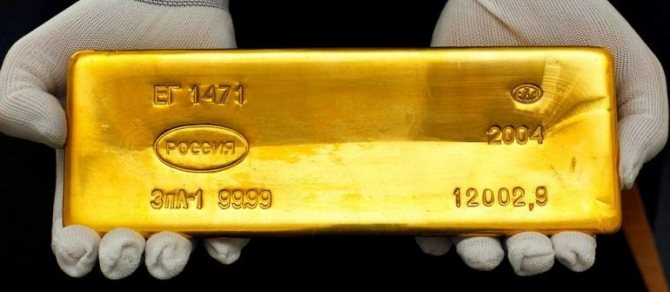
Gold bar sizes 1 and 10 kg
The size established for a kilogram measured product: length 105-116 mm, width 48-52 mm. The height of the object is not regulated.
The following proportions are used in standard samples (with a permissible deviation of ± 5 mm):
- larger base, mm – length 54, width 88;
- smaller base, mm – length 229, width 59;
- height – 35 mm.
Weight of a gold bar in storage
The precious metal of the Russian Gold and Foreign Exchange Reserve is stored mainly in objects weighing from 1 to 14 kg.
The United States prefers to store its savings in the form of bars weighing 400 troy ounces, or 12.44 kg.
How much does the largest bar weigh today?
The largest specimen in the world belongs to Japan. Its weight is 250 kilograms, which is even recorded in the famous Guinness Book of Records.
In second place is Taiwan, the happy owner of a piece of gold weighing 220 kg.
Ingots
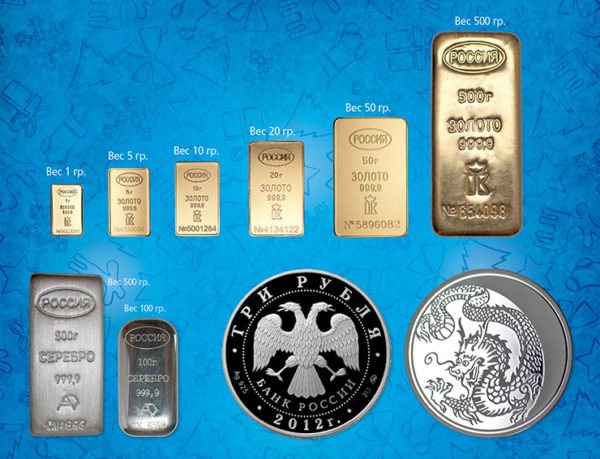
Measured gold bars are produced weighing up to 1 kg, and it is from them that the bulk of small bars in Russian banks, available for retail purchase, are made up. A .999 gold bar means it contains 99.99% pure metal. They are sold not only through banks, but also through jewelry stores.
GOST R 51572-2000 regulates the quality of gold bullion in the Russian Federation:
- Determines within what limits the length and width parameters can deviate. The same boundaries regulate the mass of the ingot.
- Requires that the edges of the final product be free of foreign inclusions, stains or scratches, traces of grease, chips, cracks and other possible defects.
- According to GOST, the surface of a gold bar is allowed to be wavy or curved, since shrinkage occurs during the technological process of metal crystallization.
- GOST requires that the sample be clear and legible. The information printed on the front side must contain information about the mass in grams, sample, manufacturer's mark, name of the metal, the inscription “Russia” in the oval and the full serial number.
- Allows the production of a gold bar, the weight, shape or size of which differs, by agreement between the consumer and the manufacturer, from the regulatory requirements of GOST.
The weight of a measured gold bar can vary from one gram to a kilogram, and GOST allows any shape of the product, even round, if the consumer wants it. The Russian banking market is represented by a huge range of these popular products.
Buying and selling
Trading in this product is primarily the prerogative of banks. You can not only buy gold there, but also leave it for storage. Such a financial investment has a high level of profitability, but only in the long term, since the purchase price will be higher than the sale, as with other foreign exchange transactions.
Expert opinion
Lyudmila Pestereva
Our most experienced gold investor
Ask a Question
Such an acquisition is subject to VAT, and upon sale the owner is charged income tax. However, these fees will be canceled if more than 3 years have passed since the date of purchase. Therefore, it will be beneficial not only not to sell gold before this period, but not even to withdraw it from the bank.
What determines the price of a bank bullion?
In addition to the current gold rate, the price of the product is tied to its weight. The buyer pays the most money if he purchases metal weighing 1 gram. The higher the weight of the ingot, the cheaper the gold is per gram.
When selling gold to a bank, some financial institutions, for example Sberbank, provide an additional commission, which increases in proportion to the weight of the item being handed over.
Products in poor condition, on the contrary, are accepted at banks, charging an additional commission of about 3% of the value of the metal.
How much does a gold bar cost in Russia 1 gram and 1 kg
As of today. 1 gram of gold costs:
| Price 999 standard according to the Central Bank | Market value of the sample today | Scrap price | Price in jewelry |
For an ingot weighing 1 kilogram you will have to pay (in million rubles):
USDRUB*GC1!*10000000/311034 chart courtesy of TradingView
Where is the best place to buy bullion?
It is always better to purchase such things from financial institutions. In this case, the possibility of forgery is eliminated and the availability of the entire package of accompanying documents is guaranteed.
Where and how to store the bullion
The storage of gold, including in coins, should also be entrusted to the bank. It’s not safe to keep such valuables at home, and there’s no point in keeping them. The financial institution opens a metal safekeeping account for the client - an analogue of a safe deposit box. You can put all your precious savings there, add new ones or withdraw the necessary part.
The cost of such a service will not depend on the number of items, their weight and even the metal from which they are made - all your savings in precious metals can be kept in one place.
To see how Russia's gold reserves are stored, watch the video:
Acquisition
It's good to know where and how to buy a gold bar. After all, this is not public access material, when you can go to the nearest store and buy a “brick”. It is important to understand domestic and global standards. In addition, know how much gold is in the bar. After all, the sample is an indicator of the amount of valuable material in the alloy, since in most cases gold is not present in the alloy in its pure form. It is a soft metal that necessarily fuses with a harder one. For example, 585 standard corresponds to a weight of 14 carats. That is, out of the entire alloy, the ingot contains 14 shares of pure gold. 999 standard corresponds to 24 carats, which means it has 24 parts of pure gold. In percentage terms it is 100%.
Gold is sold in banks or at specialized exchanges or in jewelry stores (if their weight is less than 1 kg). Moreover, in some cases you can buy not the bullion itself, but securities corresponding to its equivalent. The bullion itself may be in a safe deposit box.
What does "standard gold bar" mean?
Standard gold bars are alloys produced in Russia according to international GOST 28058–89. How much a standard gold bar weighs, and what requirements according to GOST it must meet, we will consider below. Strict compliance of the alloy mass of the metal and the sample is mandatory:
- one gold bar weighs 11,000–13,300 g;
- sample 99.95%.
Products must meet certain requirements. Namely:
- The shape is in the form of a truncated pyramid, with approved side parameters.
- According to the standards, the maximum amount of impurities is established.
- Small depressions and recesses of up to 5 mm are allowed and possible on the surface.
- The product itself must be free of greasy stains, unevenness, and impurities.
The alloy must have mandatory markings on its front surface. This:
- Ingot number and metal grade;
- fineness and mass (weight of a bank gold bar);
- name of the country of origin;
- refinery sign;
- year of issue.
Expert opinion
Evgeniy Belyaev
Legal consultant, financial expert
Ask
Standard gold bars of the highest purity and quality, bearing the hallmark of a well-known, reputable manufacturer, acquire a certain London Good Delivery status. This allows the manufacturer to enter international markets. Such bars are highly valued both in Russia and throughout the world.
